I first encountered the idea of lunar standstills at the Callanish stone circle on the Isle of Lewis in the Outer Hebrides. The story is that every 18.6 years, the moon goes through a major standstill, where it rises only a few degrees, and appears to roll along the horizon. From the viewpoint of Callanish, the moon runs along hills which have the appearance of a woman lying on her back, the so-called Sleeping Beauty or Cailleach of the Moors. After a few hours the moon sets, and then momentarily it re-appears silhouetted in a valley on the horizon. If you stand outside the circle of Callanish, the moon passes among the stones. The last major standstill was in 2006, and so the next one is due in 2025, although the effects can be seen now!
Shown below is a picture I took of the stones at Callanish with the moon behind them when I visited in May 2019. The moon was quite high at the time (peaking at around 20° above the horizon). During a standstill the moon only rises to about 3°, and because it is close to the horizon, it appears much larger!
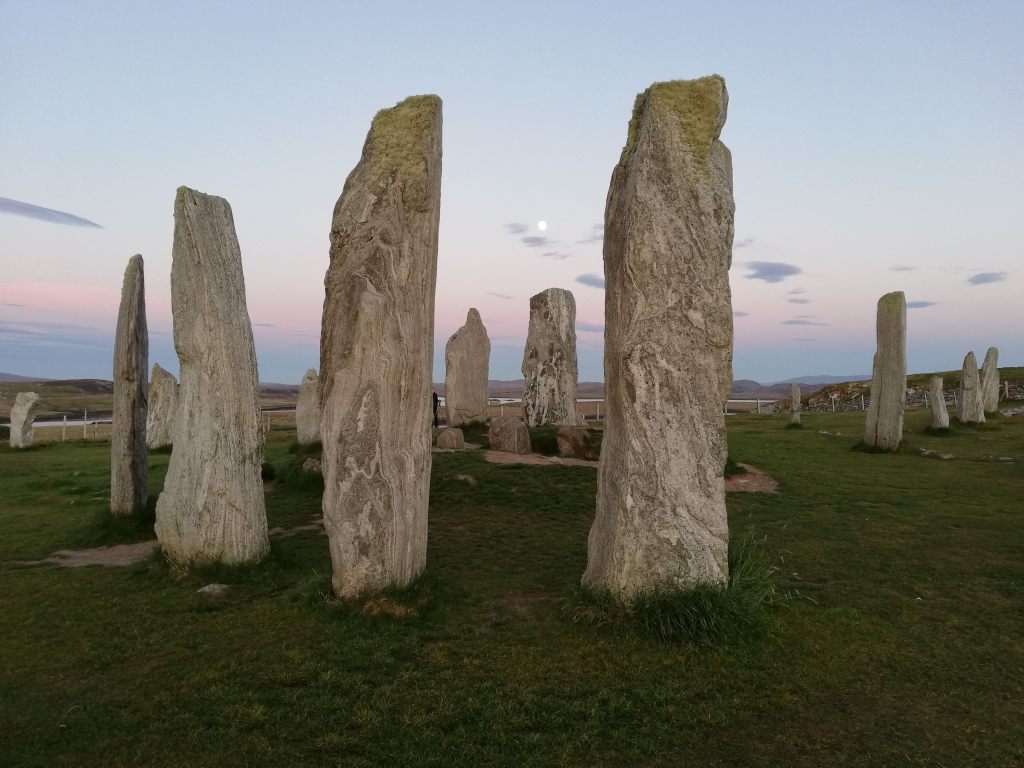
Shown below is a photo showing what the moon looks like at the standstill, with a full moon walking through the stones. (Photo from the late Margaret Curtis at https://www.geo.org/callan.htm.).
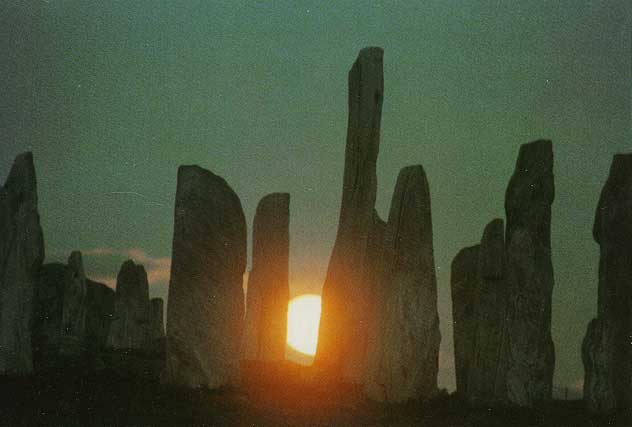
Shown below is a photo I took of the Sleeping Beauty hills from Callanish. I think the grey ones in the background are the woman, with her head to the right, laying against the ‘pillow’ of the closer hills. As you move around the island, you can still see the woman, although the outline changes a bit. From nearby Achmore stone circle, for example, the arrangement of hills makes her appear pregnant. You might like to read Jill Smith’s article on walking the Sleeping Beauty Mountain: https://goddess-pages.co.uk/galive/issue-19-home/walking-the-sleeping-beauty-mountain/
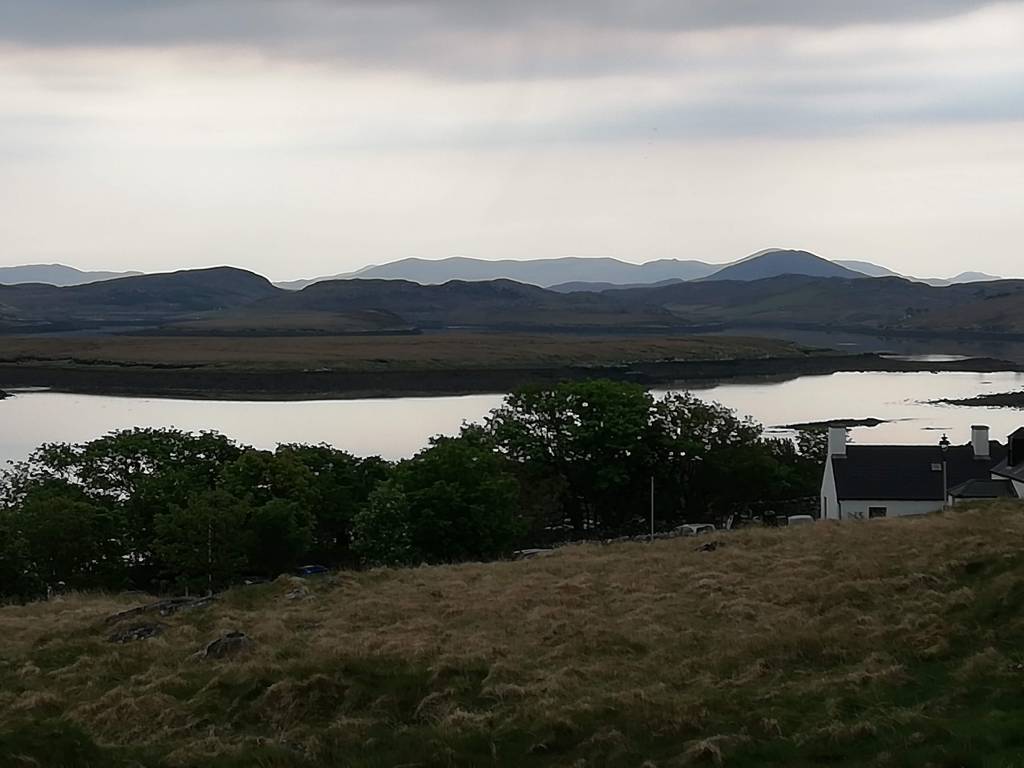
Where else do we see the standstill?
The major lunar standstill can be seen everywhere. If you are much further north than Callanish, the moon sometimes doesn’t rise at all at the standstill. At lower latitudes the moon rises higher, but still at a minimum altitude. In London for example the moon rises to about 9°, less impressive but still worth watching. If you’re in the southern hemisphere, then you get the same effect, but at a different time of year.
When can we see the standstill?
We are talking about a long (18.6 year) cycle, and so we can see the effects of the standstill (at least to some extent) for a few years on either side of the main date. We can see an echo every month (well, every 27.21 days) when the moon is at the right place in its orbit. Of course it isn’t noticeable every month, because sometimes the moon is rising in daylight or is a very thin crescent. It’s more noticeable when the moon is full. For this sequence we get a good chance of seeing it this year on 21st/22nd June 2024, and next year on 11th/12th June 2025. Details are included at the end of this article. Of course you have to have clear weather to see it properly!
Why 18.6 years?
Understanding the interval of 18.6 years between major lunar standstills is tricky, and you can skip this bit if you like!
To understand it, we have to look at the way the moon goes round the earth, and the earth goes round the sun. The diagram below illustrates the orbits. The earth (green) goes around the sun, each orbit taking a year. The plane of the earth’s orbit, called the ecliptic, is shown in yellow. The moon (blue), goes round the earth, but its (blue) orbit is not in the same plane as the ecliptic – it is tilted, by about 5.1˚ So, during one orbit, as it goes around the earth, the moon rises above the ecliptic plane, and then falls below it. The two points where it crosses over the ecliptic are called the lunar nodes: the ascending node (AN in the diagram) and the descending node (DN). The moon takes 27.21 days to make a full orbit through the nodes (this is called a draconic month).
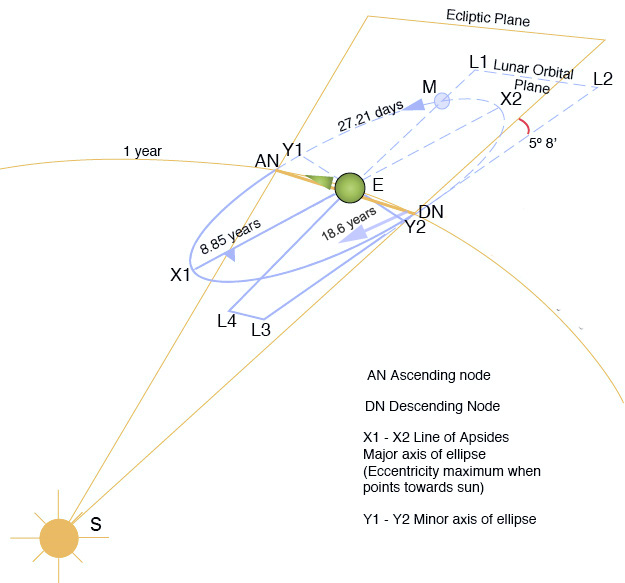
From https://en.wikipedia.org/wiki/Orbit_of_the_Moon
The orientation of the tilt in the moon’s orbit about the earth changes over a period of about 18.6 years. In the diagram as shown, the line joining the nodes is more or less perpendicular to the earth-sun line. But this line rotates so that, about 9 years later, the two nodes will line up with the sun-earth line. This is important for predicting eclipses, because an eclipse can only take place when the sun, moon and earth are aligned, which only happens if the moon is in the plane of the ecliptic (at one of the nodes).
But for major lunar standstills, we’re interested in the points where the line between the nodes is as shown in the diagram. This is because the moon in its orbit is reaching as far as it can above and below the ecliptic.
The diagram below illustrates what we see on earth. Each night the moon rises somewhere in the east, and sets at a corresponding point in the west. Every night the moonrise moves along the horizon between two limits in the north and south. The moon rises higher when the moonrise and set are in the north, and it rises less when the rise and set are in the south.
The north and south limits also move – on the 18.6 year cycle. At the major standstill, the moonrise swings in a single month from far north-east to south-east. For example in June 2025 at Callanish, the moonrise will swing between 26˚ in the northeast, to 155˚ in the southeast. Half-way through the 18.6 year cycle (at what is called the minor lunar standstill) the range of the moonrise across the month is smaller. For example in February 2016 at Callanish, the moonrise swings between 54˚ in the northeast, to 127˚ in the southeast.
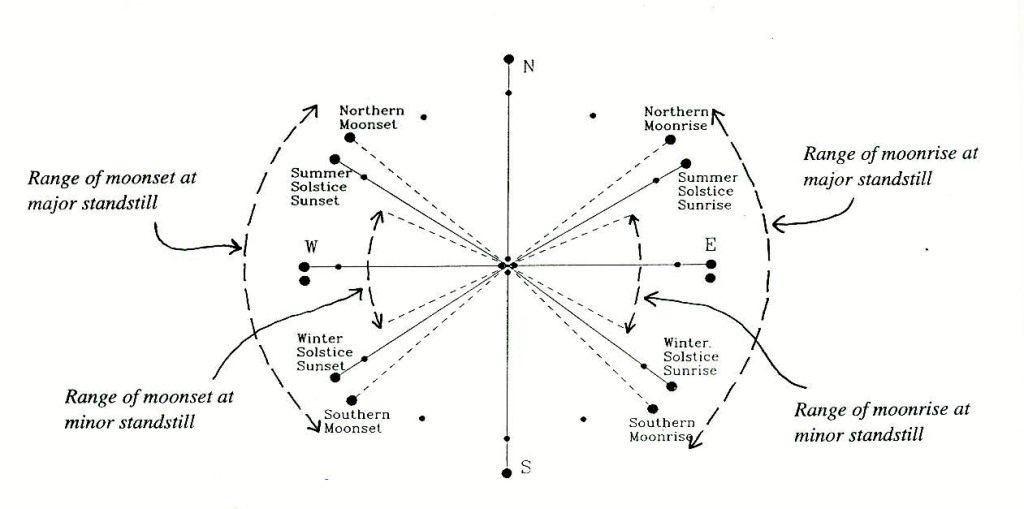
Image from https://www.umass.edu/sunwheel/pages/moonteaching.html
The 2006 Standstill
The most recent standstill was in 2006, and there is a blog by Gerald Ponting recording the event at Callanish, covering 11th-12th June: http://home.clara.net/gponting/page44.html
According to https://www.timeanddate.com/moon/@2653988?month=6&year=2006
The moon rose at 23:38 on 11th June, at 154˚ (about 25˚ East of South)
The moon set at 03:41 on 12th June at 205˚ (about 25˚ West of South)
The moon peaked at 01:40 on 12th June at an altitude of 2.8˚.
According to Gerald’s blog, the moon appeared above the sleeping figure at 12:11, and was clear of the horizon at 12:20. He didn’t see the ‘regleam’ where the moon re-appears momentarily before finally setting.
Drawing the 154˚ and 205˚ arcs on the map points roughly to the sleeping beauty (moonrise) and Glen Langadale (regleam). Both of these are on the southern part of Lewis. According to Margaret Curtis, Glen Langadale is hidden by hills to the south of Callanish, but the recleam effect is gained within the circle as the setting moon appears from behind the rocky hillock next to the circle (Cnoc an Tursa).
The 2024 and 2025 Standstill
The following moon data for Callanish illustrates that from June 2024 to June 2025, the effect repeats more of less the same, on a monthly basis. It is more easily observed at the full moons which occur near the Summer solstice.
Full moon near summer solstice 2024: 21st/22nd June
According to https://www.timeanddate.com/moon/@2653988?month=6&year=2024
The moon rises and sets at 23:26 (155˚) to 03:27 (205˚), meridian passing at 01:27 (2.7˚ altitude).
Spring equinox 2025: 22 March 2025
According to https://www.timeanddate.com/moon/@2653988?month=3&year=2025
The moon rises and sets at 04:30 (156˚) to 08:18 (204˚), meridian passing at 06:24 (2.4˚ altitude).
Full moon near summer solstice 2024: 11th/12th June
According to https://www.timeanddate.com/moon/@2653988?month=6&year=2025
The moon rises and sets at 00:02 (155˚) to 04:02 (205˚), meridian passing at 02:02 (2.7˚ altitude).
Additional Reading material:
If you want more detail have a look at https://en.wikipedia.org/wiki/Lunar_standstill.
Archaeoastronomy for Archaeologists http://www.bajr.org/BAJRGuides/43_Archaeo-Astronomy/43_ArchaeAstronomy.pdf
